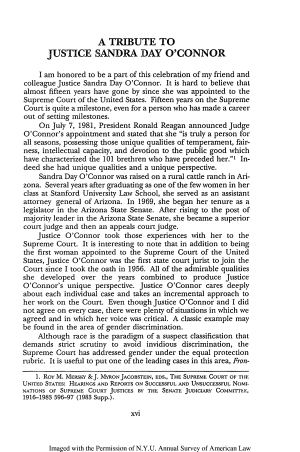A Tribute to Justice Sandra Day O’Connor
March 1, 1996

Other pages in the O'Connor Institute Online Archive mentioned in this article:
| NAME / TITLE | TYPE |
|---|---|
| William Brennan | Justice |
Article Text
(Excerpt)
A TRIBUTE TO
JUSTICE SANDRA DAY O'CONNOR
I am honored to be a part of this celebration of my friend and colleague Justice Sandra Day O'Connor. It is hard to believe that almost fifteen years have gone by since she was appointed to the Supreme Court of the United States. Fifteen years on the Supreme Court is quite a milestone, even for a person who has made a career out of setting milestones.
On July 7, 1981, President Ronald Reagan announced Judge O'Connor's appointment and stated that she "is truly a person for all seasons, possessing those unique qualities of temperament, fair ness, intellectual capacity, and devotion to the public good which have characterized the 101 brethren who have preceded her."1 In deed she had unique qualities and a unique perspective.
Sandra Day O'Connor was raised on a rural cattle ranch in Ari zona. Several years after graduating as one of the few women in her class at Stanford University Law School, she served as an assistant attorney general of Arizona. In 1969, she began her tenure as a legislator in the Arizona State Senate. After rising to the post of majority leader in the Arizona State Senate, she became a superior court judge and then an appeals court judge.
Justice O'Connor took those experiences with her to the Supreme Court. It is interesting to note that in addition to being the first woman appointed to the Supreme Court of the United States, Justice O'Connor was the first state court jurist to join the Court since I took the oath
